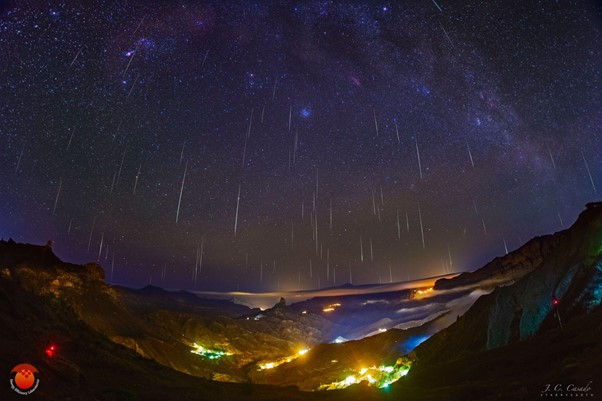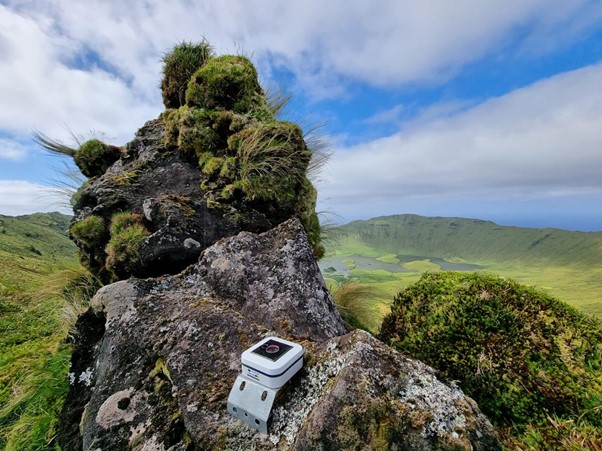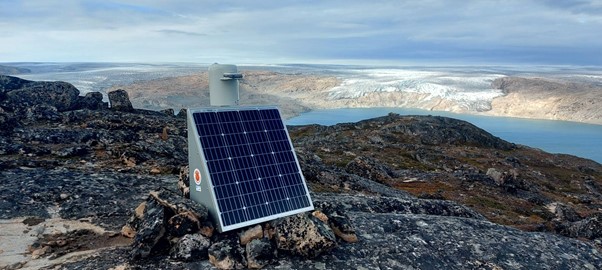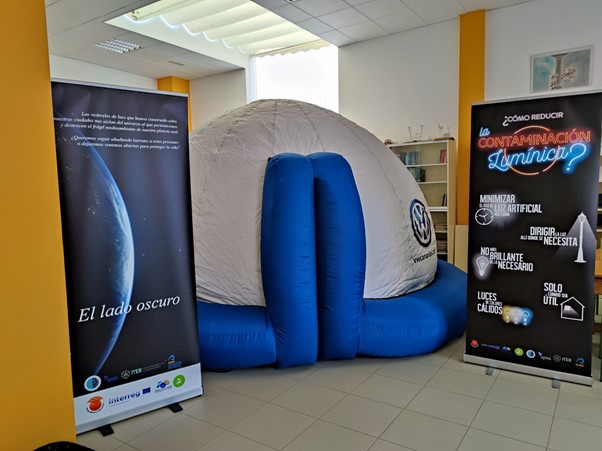The results obtained by over two hundred photometers deployed by the Interreg EELabs project over the past four years have served to assess the impact of artificial night light on nocturnal ecosystems in the archipelagos – especially seabirds – but also to raise awareness among the population about the consequences of this type of pollution.
In Macaronesia, natural darkness is only preserved in very isolated natural reserves such as the islands of Corvo or Graciosa (Azores), Alegranza (Chinijo Archipelago, Canary Islands), or protected by law like the Roque de Los Muchachos Nature Park (La Palma, Canary Islands).
Since the beginning of the Interreg EELabs project in late 2019, 12 networks of photometers have been installed to monitor the natural darkness of natural spaces in the different archipelagos of Macaronesia. A total of 222 autonomous photometers, developed for this project, are distributed across the islands of Tenerife, La Palma, Madeira, Corvo, Flores, Gran Canaria, La Graciosa, Alegranza, Lanzarote, La Gomera, Fuerteventura, El Hierro, Desertas Islands, Graciosa, and São Miguel. The information they collect is sent to the public IoT-EELab portal, allowing the scientific and educational community to make use of it.
The initial conclusions are clear: natural darkness is only preserved in very isolated natural reserves such as the islands of Corvo or Graciosa (Azores), Alegranza (Chinijo Archipelago, Canary Islands), or protected by law like La Palma. The rest of the measured locations show a medium excess of light pollution (LPE) of 40%.
«EELabs has provided a quantitative snapshot of light pollution in the main natural spaces of Macaronesia. Although it is true that isolated places like Corvo, Graciosa, or Alegranza, or those protected by law like La Palma, preserve natural darkness, in general, light pollution is present at all measured points. We must pay special attention to the island of Gran Canaria. Of the 25 photometers installed in the municipality of Tejeda, the best darkness was measured at the Parralillo Dam, and yet it still has an excess of light pollution of 48%. If we want to preserve the darkness of the Canarian skies, it is necessary to regulate, sustainably, the lighting of large population centers starting with the two capitals,» comments Miquel Serra-Ricart, researcher at IAC and project coordinator.
But the networks of photometers – called Light Pollution Laboratories (LPL) – also consist of MiNiO controllers whose purpose is twofold: on the one hand, to facilitate the sending of data from the photometers and, on the other hand, to provide information about the meteorological conditions of the point where they are located.
Initially, the MiNiO controllers needed an electrical supply point to perform their functionality, but after the need arose to install them in protected natural areas, ITER, as a project partner, proposed the technical solution that best adapted to the physical, energy, and operational characteristics of these devices. The solution consisted of implementing a photovoltaic power supply system alongside the device, providing it with energy autonomy throughout the year, or most of it, and allowing its installation in natural spaces by harnessing the available solar resource. They started with the construction of a functional prototype that was tested at the Teide Observatory and later installed on the cable car of the Teide National Park. This equipment was used as a model for the construction of the following Autonomous MiNiOs installed in Madeira (Pico do Arieiro Natural Park) and Greenland (Qaleraliq Glacier Front).
The results obtained by all these devices have led to a method for calibrating satellite images. This system is aimed at evaluating light pollution in more detail. Satellite images are not sensitive enough to take precise measurements in very dark areas, unlike photometers, which do not have this limitation. For this reason, the resulting map is extremely valuable as it combines both sources and enables a very accurate analysis of nighttime brightness worldwide.
Impact on nocturnal ecosystems
Light pollution affects several species of seabirds, and Macaronesia is home to 10 of them. Many of the younger specimens of these species, attracted by city lights during their first flights, end up dying. Therefore, within the framework of the Interreg EELabs project, several volunteer initiatives have been carried out that have allowed the rescue of hundreds of birds; and thousands of students from Madeira and the Azores have learned about this problem and act as ambassadors for the conservation of seabirds and dark skies, as a measure to protect biodiversity. The installation of photometers and the monitoring of Cory’s shearwaters using GPS devices have allowed for a better understanding of how these birds interact with coastal lighting, as well as providing very important data on the ecology of this species. All these initiatives will be developed and continued in the LIFE Natura@night project.
In order to protect nocturnal ecosystems and the starry sky from artificial light at night, the municipalities of Güímar, Santiago del Teide, and Mogán have committed to expanding their regulations to protect the night through collaboration agreements within the framework of the Interreg EELabs project. These are the first municipalities in Macaronesia to propose to ensure the protection of natural darkness at night through municipal ordinances, but new initiatives that are already underway, such as the LIFE Natura@night project, collaborate with many other municipalities willing to preserve nocturnal ecosystems under the motto «For a Night with More Life.»
In addition to the commitment of public administrations, another very important part of the project has been to raise awareness among the population about the problem of light pollution. In order to convey the need to protect the darkness of the night, 25 broadcasts of celestial events, such as meteor showers, eclipses, or auroras, have been carried out; in addition to the #UniversoEnCasa series, which took place during the first weeks of COVID-19 lockdown. These videos are complemented by face-to-face talks in educational centers, museums, open days, and planetariums, and the film «The Dark Side,» also translated into Portuguese, to continue spreading the importance of preserving the starry sky.
EELabs (eelabs.eu) is a project funded by the INTERREG V-A MAC 2014-2020 Program, co-financed by the European Regional Development Fund (ERDF) of the European Union, under contract number MAC2/4.6d/238. EELabs works with 5 centers in Macaronesia (IAC, ITER, ULPGC, SPEA-Azores, and SPEA-Madeira). The objective of EELabs is to create Laboratories to measure the Energy Efficiency of Artificial Night Light in protected natural areas of Macaronesia (Canary Islands, Madeira, and Azores).
The LIFE Natura@night project is co-financed by the European Union’s LIFE program, coordinated by SPEA, and has partners such as Câmara de Lobos, Câmara Municipal do Funchal, Câmara Municipal de Santa Cruz, Câmara Municipal de Machico, Câmara Municipal de Santana, Câmara Municipal de Santa Cruz da Graciosa, Direção Regional dos Assuntos do Mar, Instituto das Florestas e Conservação da Natureza, Instituto de Astrofísica de Canarias, Instituto Tecnológico de Canarias, Fluxo de Luz, and the Sociedad Española de Ornitología.
Scientific Articles:
Alarcon, M.R., Serra-Ricart, M., Lemes-Perera, S. & Mallorquín, M. (2021). Natural Night Sky Brightness during Solar Minimum. The Astronomical Journal, Vol. 162, Num. 1. DOI: 10.3847/1538-3881/abfdaa
Alarcon, M.R., Puig-Subirà, M., Serra-Ricart, M., Lemes-Perera, S., Mallorquín, M. & López, C. (2021). SG-WAS: A New Wireless Autonomous Night Sky Brightness Sensor. Sensors 2021, 21(16), 5590; https://doi.org/10.3390/s21165590
Fernandez-Ruiz, B., Serra-Ricart, M., Alarcon, M. R., Lemes-Perera, S., Santana-Pérez, I., & Ruiz-Alzola, J. (2023). Calibrating nighttime satellite imagery with red photometer networks. Remote Sensing, 15(17), 4189. https://doi.org/10.3390/rs15174189
Relevant Links:
IoT EELab data portal: https://data.eelabs.eu/
Light pollution map: https://data.eelabs.eu/map




